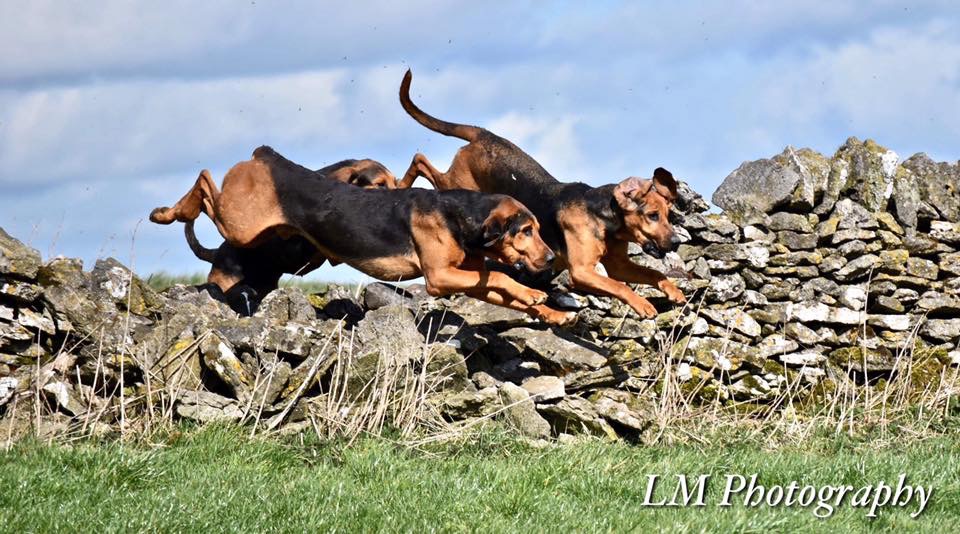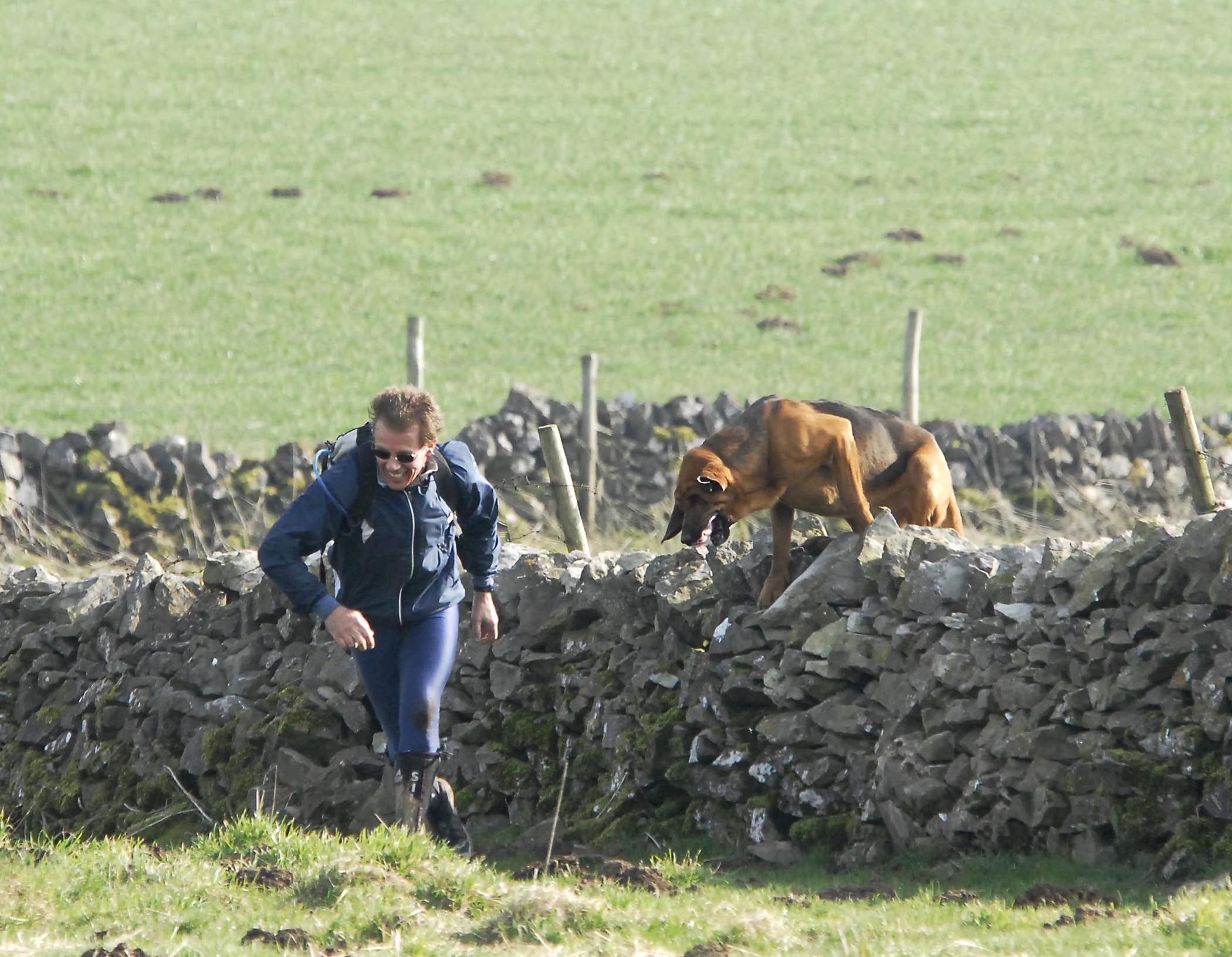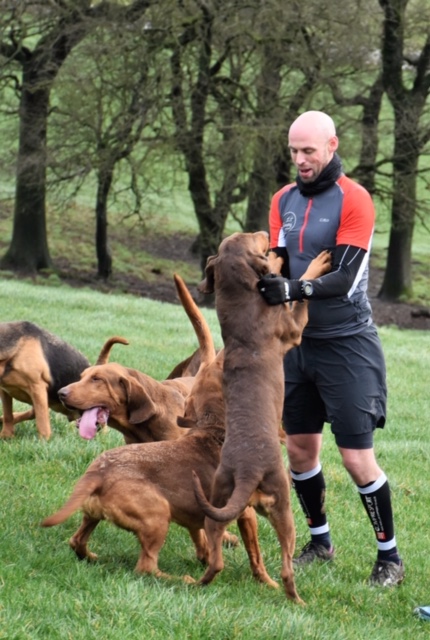
At the Millennium the Lady Hattersley persuaded the late Dowager Duchess of Devonshire and Sir Andrew Buchanan to help her form The Four Shires. In the 1920s the Mitford girls were regularly hunted – their father, Lord Redesdale, liked nothing better than to hunt the children of the family round the estate with his pack of Bloodhounds. The youngest child, the late Dowager Duchess of Devonshire, was regarded as too small to be a quarry. But like her father, our Founding President, always had a particular soft spot for these charming hounds.
Our President, the Duchess of Devonshire, DL and the Duke generously host our meets at Chatsworth. The Duchess is keen that young enthusiasts are able to sample a day’s hunting with these lovely, loose-skinned, lolloping hounds.
While this ancient hound traces its ancestry back to the Greeks and Romans, the modern breed has an ecclesiastical lineage. St Hubert, a monk who lived in the Ardennes region of France in the 8th century, refined the breed, which the Normans brought with them to Britain. The name Bloodhound refers to the fine bloodlines, rather than a taste for blood. As a scent hound, it has no equal. The long droopy ears help to couple the scent to the nostrils, giving a Bloodhound a scenting ability 800 times that of man. The remarkable tracking ability of this noble breed is legendary, and there is no better opportunity of seeing it in action than to follow a pack of Bloodhounds out hunting.

So what about the quarry? The sport of hunting with Bloodhounds is known as hunting the clean boot. Unlike a draghunt which uses an artificial pre-laid scent, Bloodhounds have to work the scent (which is affected by the weather) of a human quarry – a fell runner or a marathon runner. These hounds are very affectionate and on finding their quarry at the end of the meet, they often lick the runner.
Because Bloodhounds are very hardworking and diligent, and they “speak” when they find the scent of their quarry, it is also an excellent spectator sport and attracts a large foot and car following at the meets. The Boxing Day meet is held in the centre of Ashbourne and attracts several thousand well-wishers to see the pack depart. Spectators can see where the runner has gone and then enjoy seeing hounds racing along the same path. In windy conditions, hounds can be seen running slightly in parallel. Because the routes are pre-planned, The Four Shires are able to provide directions/maps indicating the best viewing points. Keen photographers often follow and we display their work on this site and in on Facebook.
Hunting the clean boot is a farmer-friendly sport. As the runner memorises the route, hounds pass quickly through farms in pursuit and do not double back. More important, as the quarry is human, the exact route can be agreed in advance with the farmers and landlords over whose land it crosses. Thus fields which have new seed or breeding stock can be avoided. As the route is pre-planned and hounds follow the quarry’s scent, 12-20 miles can be covered in a couple of hours. The day starts and ends at the same place. To encourage novices and the less confident, The Four Shires has a second field master leading those riders who want to take things more gently and/or avoid jumping.
The Four Shires tries to appeal to a large section of the community. Social events attract non-riders and members of Young Farmers and farmers and landowners over whose land it crosses.

The way the pack works together is fascinating. When the pack arrives at the meet, the hounds are un-boxed and introduced to the quarry. At the outset, master kennel-huntsman, Chris Kane, will encourage hounds and say things like "here he is" or "here she is", just so that the hounds know they have to register the scent. The runner is given a 10-20-minute head start. After the first hunt, the quarry is driven by road to the next starting point,; so they do not seek the quarry on the roads. On arrival, hounds cast themselves on again. Bloodhounds are wonderfully committed. If they loose the scent for a few strides, they quickly correct themselves. Whenever the scent ends the hounds will "check"; then it's the huntsman’s job to "lift" hounds and move them on to the field from where the runner has begun the next stage of the hunt. The hounds will draw that field and work out the next line. By this time, the quarry is usually hard pressed and has to be very quick to avoid being caught.

In a day's hunting this is repeated a number of times. At the end of the day, during which time hounds can have covered up to 25 miles, the pack is allowed to "catch" the quarry, who has to cope with the inevitable delight and elation of these affectionate hounds.
The Four Shires’ season is from mid-August to early April, hunting on Sundays and with some bye days. Autumn hunting starts with hound exercise days – a cross country ride with hounds at foot. Hound exercises are an excellent way to get horses and riders hunting fit and green horses accustomed to hounds. They are also perfect for novices who want to get a taste of the sport. There are optional jumps for those who want to have a pop. There is no runner on hound exercise days, but if hounds pick up a scent, they may well start to “speak” as these hounds are very chatty.
Bloodhound hunting – as opposed to hound exercises – is a day for riders with horses capable of crossing the country. It is a great day for people and horses, who love their jumping. Most of the obstacles are natural, so a horse that pricks his ears at the sight of hedges and stonewalls is just the job. An alternative route round with a second fieldmaster is always provided for those riders wanting a less challenging day. But always check with the Hunt Secretary that the meet is suitable for horse and rider.
Riders and car followers enjoy watching these dedicated hounds work – the field goes at hounds’ pace, which is far from slow. But it is not a team chase or a drag hunt – rather a chance to observe houndwork in magnificent country.
The Four Shires hunt by the generous invitation of farmers and landowners who have taken to enjoying the spectacle these hounds provide. The rich deep music, which Bloodhounds make when hunting, is glorious and unforgettable.
The Hunt is a member of the Masters of Draghounds and Bloodhounds. Chris Kane, MBH is vice-chairman of the MDBA.



